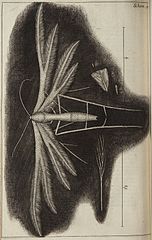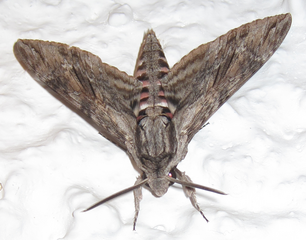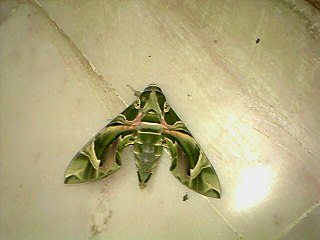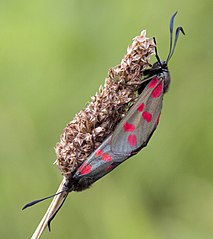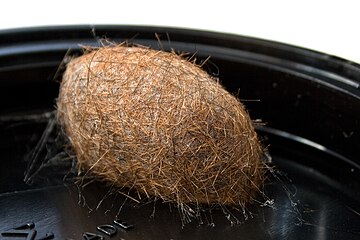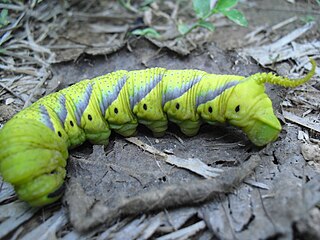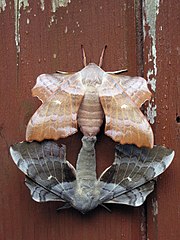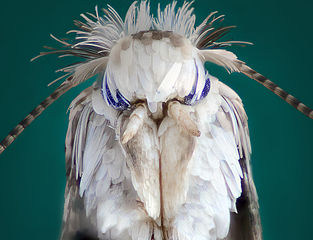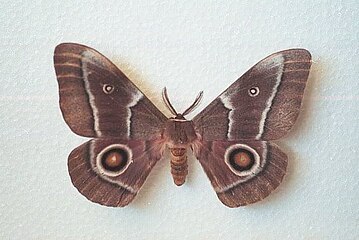Heterocera


Heterocera sunt polyphyleticus insectorum grex, qui omnes animalia ordinis Lepidopterorum non Rhopalocera comprehendit, et Heterocera sunt plurimae ordinis partes. Circa 160 000 specierum Heterocerorum esse putantur,[1] quorum permulta nondum descripta sunt. Plurimae Heterocerorum species sunt nocturnae, sed aliae sunt crepusculares, aliaeque diurnae. Rhopalocera grex monophyleticus sunt, sed heterocera, reliquum lepidopterorum constituentia, non sunt.
Heterocera notabilia[recensere | fontem recensere]
- Attacus atlas, maxima mundi heterocerum
- Thysania agrippina, lepidoptera cui est maximum alarum spatium
- Chrysiridia rhipheus, unum e praestantibus pulchrisque lepidopteris habitum[2]
- Acherontia spp. cum malo et supernaturalibus coniungitur, et in arte et pelliculis monstratur
- Biston betularia, res certi studii selectionis naturalis nota est
- Actias luna
- Aglossa cuprina, quae redito hominum adipe vesci nota est[3]
- Opodiphthera eucalypti
- Antheraea polyphemus
- Agrotis infusa, cibus nonnullorum indigenarum Australianorum
- Utetheisa ornatrix, res multorum studiorum morum de selectione sexuali
Heterocera magni momenti oeconomici[recensere | fontem recensere]
- Lymantria dispar, invasivus arborum ligni duri vexator in America Septentrionali
- Operophtera brumata, invasivus arborum ligni duri atque Oxycoccorum et Vacciniorum in America Septentrionali boreo-orientali vexator
- Helicoverpa zea, agriculturalis vexator exitialis
- Plodia interpunctella, vexator frumenti et farinae
- Cydia pomonella, vexator praecipue arborum mali, pyri, et juglandis
- Epiphyas postvittana, vexator vehementer polyphagus
- Bombyx mori, pro serico
- Galleria mellonella, vexator alveorum apium
- Duponchelia fovealis, invasivus holerum et plantarum ornamentalium nuper in Civitatibus Foederatis adveniens
Pinacotheca[recensere | fontem recensere]
-
Zygaenae filipendulae coientes
-
Globulus serici vel materiei similis
-
Eruca generis Acherontiae
-
Par Laothoarum populi coientes varios colores monstrantes
-
Gonimbrasia belina adultus
-
Una e Sphingidis ex Kerala
Notae[recensere | fontem recensere]
- ↑ "Moths". Smithsonian Institution
- ↑ Tait, Malcolm (2006). Animal Tragic: Popular Misconceptions of Wildlife Through the Centuries. Think Books. p. 38. ISBN 978-1-84525-015-7.
- ↑ Brundage, Adrienne (March 23, 2009), "Other Arthropods of Forensic Importance," Texas A&M University, Texas A&M University Forensic Entomology Lecture.
Bibliographia[recensere | fontem recensere]
- Britton, David. 2017. "What are the differences between butterflies and moths?" Australian Museum, 1 Maii 2017.
- Carter, D. J., et B. Hargreaves. 2005. Guide des chenilles d'Europe. Lutetiae: Delachaux et Niestlé. ISBN 978-2-603-01444-8.
- Chinery, Michael. 2012. Insectes de France et d'Europe occidentale, Lutetiae: Flammarion. ISBN 978-2-0812-8823-2.
- Choe, D.-H. "Clothes Moths." In How to Manage Pests: Pests of Homes, Structures, People, and Pets. Berkeleiae: University of California Press.
- Collectif d'entomologistes amateurs. 2007. Guide des papillons nocturnes de France. Lutetiae: Delachaux et Niestlé. ISBN 978-2-603-01429-5.
- Darby, Gene. 1958. What Is a Butterfly. Sicagi: Benefic Press.
- Heppner, John B. 2005. "Moths (Lepidopter: Heterocera)." In Encyclopedia of Entomology, ed. John L. Capinera, 2491. Springer Verlag. ISBN 978-0-7923-8670-4.
- Knop, Eva, Leana Zoller, Remo Ryser, Christopher Gerpe, Maurin Hörler, et Colin Fontaine. 2017. "Artificial light at night as a new threat to pollination." Nature 548 (7666): 206–209. Bibcode:2017Natur.548..206K. doi:10.1038/nature23288. ISSN 0028-0836. PMID 28783730.
- Kristensen, Niels P., Malcolm J. Scoble, et Ole Karsholt. 2007. "Lepidoptera phylogeny and systematics: the state of inventorying moth and butterfly diversity." Zootaxa 1668: 699–747.
- Leraut, P. 2009. Papillons de nuit d'Europe: Géomètres. NAP éditon.
- Orhant, G. 2011. Atlas des papillons de nuit du Nord-Pas-de-Calais.
- Scoble, M. J. 1995. The Lepidoptera: Form, function and diversity. Oxoniae: Oxford University Press.
- Seitz, Adalbert. 1913. he Macrolepidoptera of the world; a systematic description of the hitherto known Macrolepidoptera. I. Division: The Macrolepidoptera of the Palaearctic Fauna. II Volume: Bombyces and Sphinges. Verlag des Seitz’schen Werkes (Alfred Kernen). Stutgardiae.
- Singh, Shiv Sahay. 2018. "Moths are key to pollination in Himalayan ecosystem." The Hindu. ISSN 0971-751X.
- Tait, Malcolm. 2006. Animal Tragic: Popular Misconceptions of Wildlife through the Centuries. Think Books. ISBN 978-1-84525-015-7.
- van Langevelde, Frank, Marijke Braamburg-Annegarn, Martinus E. Huigens, Rob Groendijk, Olivier Poitevin, Jurriën R. van Deijk, Willem N. Ellis, Roy H. A. van Grunsven, et Rob de Vos. 2018. "Declines in moth populations stress the need for conserving dark nights." Global Change Biology 24 (3): 925–32.
Nexus interni

Nexus externi[recensere | fontem recensere]
| Vicimedia Communia plura habent quae ad Heterocera spectant (Lepidoptera, Moths). |

